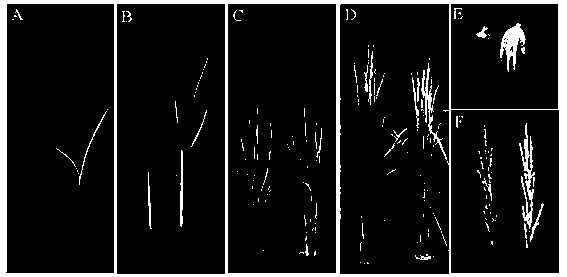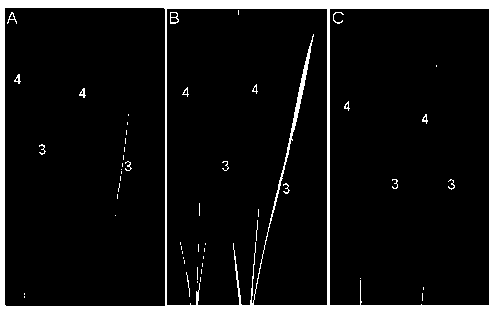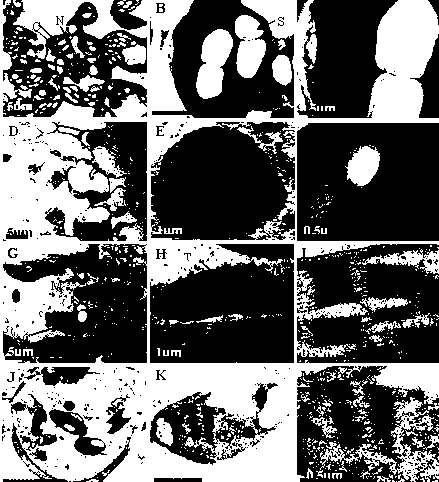Protein for regulating and controlling chloroplast growth and gene and application thereof
A protein and chloroplast technology, applied in the field of genetic engineering
- Summary
- Abstract
- Description
- Claims
- Application Information
AI Technical Summary
Problems solved by technology
Method used
Image
Examples
Embodiment 1
[0035] Example 1: Cloning of the WLP1 gene
[0036] a) Rice material
[0037] Rice (Oryza sativa L) mutant wlp1 (white leaf and panicle 1), the original wild-type material is the japonica rice variety Asominori.
[0038] b) Electron microscope observation
[0039] Using transmission electron microscopy (TEM) to observe the chloroplast ultrastructure of the third leaf of wild type and wlp1 at 23 °C, it was found that the wild type chloroplast contained normal lamella structure, while wlp1 contained less cysts similar to the plastid structure Vesicular chloroplasts, the observation of young panicle chloroplasts at the heading stage found that the mutants had less lamellar accumulation than the wild type ( image 3 ).
[0040] c) Genetic analysis and mapping populations
[0041] wlp1 was determined to be a recessive mutant by reciprocal hybridization, and the mutant was selected for hybridization with NanJing 11, the F1 generation was self-crossed, and a single plant was harv...
Embodiment 2
[0070] Embodiment 2: transgenic experiment
[0071] 1) Vector construction
[0072] Design a pair of primers that completely cover the entire WLP1 gene ORF, and design restriction sites BamHI and Sal1 on the primers, PCR amplifies the wild-type genomic DNA, electrophoresis detection gel recovery, and the recovered product is digested with BamHI and Sal1 , connected to the pCAMBIA2300 vector that was digested with the same restriction enzymes, and sequenced to confirm that no base mutation occurred. The constructed vector structure diagram is pCAMBIA-WLP1( Figure 4 ), the constructed vector was transformed into Agrobacterium tumefaciens strains by electric shock method.
[0073] The primer sequence for amplifying the ORF sequence is:
[0074] SJg-BamHI:5'-TTTGGATCCCAAGCCAGACGGACAAGAC-3' (SEQ ID NO.10)
[0075] SJg-SalI: 5'-TTTGTCGACTGAGATTGTTGTGTCTTTCTTAGTC-3' (SEQ ID NO.11)
[0076] 2) Genetic transformation:
[0077] (1) Selection of transformed receptors
[0078] The ...
Embodiment 3
[0082] Example 3: Chloroplast subcellular localization experiment of WLP1 (SEQ ID NO.2)
[0083] According to the full-length CDS sequence (SEQ ID NO.3) of WLP1, a restriction recognition site containing BamHI was designed, and recombinant primers were designed. The sequence is:
[0084] SJGFP-F: CGGTCCCGGGGGATCCATGGCTACGGCCATCGC (SEQ ID NO. 12)
[0085] SJGFP-R: TGCTCACCATGGATCCCTTCTCAGACTTCTGTATTCTTTTA (SEQ ID NO. 13)
[0086] Using the wild-type cDNA as a template, the CDS sequence (SEQ ID NO.3) of the WLP1 gene was amplified with PrimeSTAR high-fidelity enzyme. After the sequence of the amplified product was verified to be correct, it was ligated with the PAN580-GFP vector to obtain the fusion expression vector 35S ::WLP1::GFP. The plasmids of the fusion expression vector 35S::WLP1:GFP and the 35S::GFP control plasmid without gene fusion were extracted and introduced into rice protoplast cells by PEG-mediated method. The introduced rice protoplast cells were cultured in h...
PUM
 Login to View More
Login to View More Abstract
Description
Claims
Application Information
 Login to View More
Login to View More - R&D
- Intellectual Property
- Life Sciences
- Materials
- Tech Scout
- Unparalleled Data Quality
- Higher Quality Content
- 60% Fewer Hallucinations
Browse by: Latest US Patents, China's latest patents, Technical Efficacy Thesaurus, Application Domain, Technology Topic, Popular Technical Reports.
© 2025 PatSnap. All rights reserved.Legal|Privacy policy|Modern Slavery Act Transparency Statement|Sitemap|About US| Contact US: help@patsnap.com



